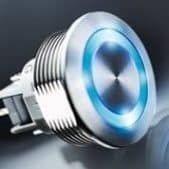Introduction The term “The Internet of Things” is a concept that went from a novel (like Bitcoin or Streaming or something similar) to a phrase that is as household as a Spying Siri or an Alert Alexa. Way back, when I was a green engineer, the nominal upper frequency for testing PCs and the like was 1 GHz. System clocks ticked along at a blistering 25 MHz. Jump a generation … [Read more...]
Connectivity for Off-Road Vehicles – Part 3
Zonal Architecture for Vehicles Zonal architecture is the name given for the new structure of vehicle electronics. In contrast to a traditional vehicle in which systems are grouped by function, zonal architecture offers a more efficient solution. The functions within a vehicle are grouped by location into several zones. Each zone is responsible for the devices that are … [Read more...]
Connectivity for Off-Road Vehicles – Part 2
The Future of Vehicle Design The next generation of vehicle design will be influenced by four key trends. The first is electrification – the adoption of hybrid and all-electric power as alternatives to traditional fossil fuels. The use of electric power by commercial vehicles has become commonplace in the urban environment, where operators have easy access to charging … [Read more...]
Connectivity for Off-Road Vehicles – Part 1
Introduction With over 1.4 billion cars worldwide, it is easy to assume that the only product of the automotive industry is the family car. However, the market for industrial, commercial, and agricultural vehicles is not only growing, but it is also embracing the latest technology. Even as these vehicles are becoming increasingly sophisticated, a significant number will … [Read more...]
A Beginner’s Guide to EMP Filters – Part 2
Resiliency of Critical Infrastructure Presidential Policy Directive (PPD) -21, Critical Infrastructure Security and Resilience directs all federal departments and agencies to identify, prioritize and provide a plan to protect their physical and cyber critical infrastructure. The U.S. Department of Labor created the DOL Critical Infrastructure Security & Resilience Program … [Read more...]
A Beginner’s Guide to EMP Filters – Part 1
Introduction While many may be concerned by an outright nuclear attack on US soil, the emerging clear and present danger predicted by government and private think tanks is Electromagnetic Pulse (EMP) threats. Such a threat, carried out by strategically placed land devices, could be catastrophic to virtually every facet of our civilization. Organizations both public and … [Read more...]
MSM II – The New Generation of Mechanical Pushbuttons Made of High-Grade Stainless Steel
Santa Rosa, California, September 1st, 2023 – SCHURTER extends its popular momentary pushbutton switch series MSM to include the newest addition, the MSM II. The MSM Metal Line switch family has been successfully used on the market for over 30 years, which is attributed to its durability, precision, and overall high quality. The new generation MSM II stands out even more as it … [Read more...]
Schurter Sets New Benchmark in Reducing CO2 Footprint with New Green Line
Santa Rosa, California, July 27th, 2023 – SCHURTER further embarks on its sustainability initiatives by introducing its new Green Line collection of high-quality components. As part of SCHURTER’s sustainable strategy, these IEC 60320-1 appliance connectors are the industry’s first to contribute to less CO2 emissions and lower material consumption. They are also first in the … [Read more...]
Fundamental Oscilloscope Probes
As electronics have become more advanced, so has the equipment used to measure their signal behavior and system performance. In the realm of EMC compliance, oscilloscopes are one of the important tools used to measure signals, hunt down noise sources, and identify time-domain measurements that may contribute to radiated or conducted emissions. Without a properly selected probe, … [Read more...]
The Voltage Rises
Santa Rosa, California, July 24th, 2023 – In the past, automobiles had minimal electrical systems and relied mainly on mechanical systems. Today, there are many electrical functions such as seat heating and cooling, comfort systems, and assistance systems that draw a lot of electricity from the battery. In a 12V vehicle electrical system, higher and higher currents must flow. … [Read more...]
- « Previous Page
- 1
- …
- 4
- 5
- 6
- 7
- 8
- …
- 650
- Next Page »














